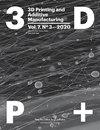Influence of Raster Orientation and Feeding Rate on the Mechanical Properties of Short Carbon Fiber-Reinforced Polyamide Printed by Fused-Filament Fabrication
IF 2.1
4区 工程技术
Q3 ENGINEERING, MANUFACTURING
引用次数: 0
Abstract
Fused-filament fabrication (FFF) is an extremely popular additive manufacturing process due to its affordability, relative ease to operate, and wide range of possible materials. It is also notorious for the hundreds of different process variables, which often are overlooked in favor of parameters considered to be more relevant for mechanical performance, such as printing and bed temperatures, printing speed, and layer height. Thus, this study is aimed at evaluating some of the less frequently studied process variables, namely raster orientation angles (and their stacking sequence) and feeding rate. Based on this, the influence of these variables on the tensile and flexural properties of short carbon fiber-reinforced polyamide printed by FFF was assessed. The study concluded that stacking layers with raster angles of 0°/90° and +30°/−30° resulted in the best trade-off between tensile and bending properties, with the former reaching ultimate tensile and flexural strengths of 111 ± 1 and 137 ± 5 MPa, respectively. The study also found that there was no increase in part density or mechanical properties when the volumetric flow was increased up to 120% of the intended road volume. Therefore, the hypothesis that an increase in flow rate would result in less inter-road gaps could not be confirmed with the current setup.栅格取向和进给速率对熔丝打印短碳纤维增强聚酰胺力学性能的影响
熔丝制造(FFF)是一种非常受欢迎的增材制造工艺,因为它的可负担性,相对容易操作,以及广泛的可能材料。它也因数百种不同的工艺变量而臭名昭著,这些变量经常被忽视,而被认为与机械性能更相关的参数,如打印和床温、打印速度和层高。因此,本研究旨在评估一些较少研究的过程变量,即光栅取向角(及其堆叠顺序)和进料速率。在此基础上,评估了这些变量对FFF打印短碳纤维增强聚酰胺拉伸和弯曲性能的影响。研究结果表明,栅格角度为0°/90°和+30°/−30°的叠加层在拉伸和弯曲性能之间取得了最佳平衡,前者的极限拉伸和弯曲强度分别达到111±1和137±5 MPa。研究还发现,当体积流量增加到预期道路体积的120%时,部分密度或机械性能没有增加。因此,流量增加会导致道路间距减小的假设在目前的设置下无法得到证实。
本文章由计算机程序翻译,如有差异,请以英文原文为准。
求助全文
约1分钟内获得全文
求助全文
来源期刊

3D Printing and Additive Manufacturing
Materials Science-Materials Science (miscellaneous)
CiteScore
6.00
自引率
6.50%
发文量
126
期刊介绍:
3D Printing and Additive Manufacturing is a peer-reviewed journal that provides a forum for world-class research in additive manufacturing and related technologies. The Journal explores emerging challenges and opportunities ranging from new developments of processes and materials, to new simulation and design tools, and informative applications and case studies. Novel applications in new areas, such as medicine, education, bio-printing, food printing, art and architecture, are also encouraged.
The Journal addresses the important questions surrounding this powerful and growing field, including issues in policy and law, intellectual property, data standards, safety and liability, environmental impact, social, economic, and humanitarian implications, and emerging business models at the industrial and consumer scales.
 求助内容:
求助内容: 应助结果提醒方式:
应助结果提醒方式:


